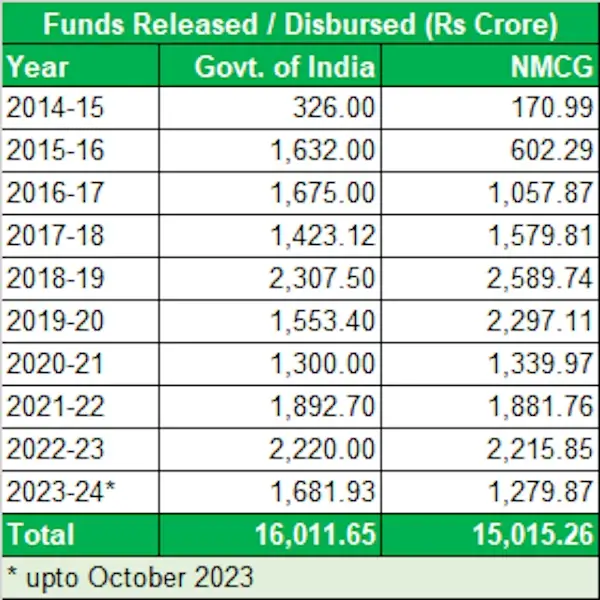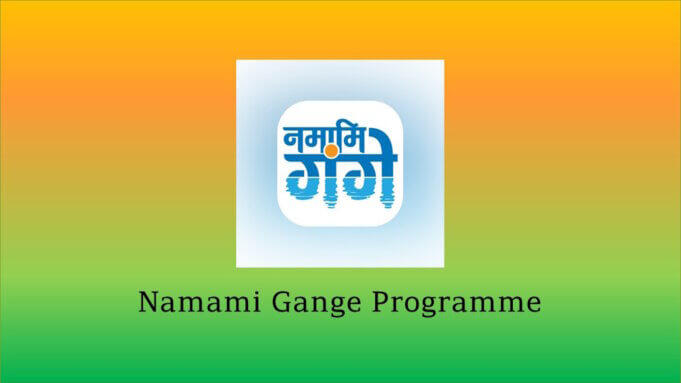The Namami Gange Programme, initiated in June 2014 with an initial end date of 31 March 2021, aimed to revive the River Ganga and its tributaries. Later, this program was extended until 31 March 2026. The Indian government allocated a total of Rs 16,011.65 crore to the National Mission for Clean Ganga (NMCG) from the fiscal year 2014-15 through 31 October 2023. NMCG disbursed Rs 15,015.26 crore to various agencies during this period.
The Central Pollution Control Board (CPCB) estimated that 3,558 million litres per day (MLD) of sewage were generated from 110 Ganga-front towns in five Ganga main stem states: Uttarakhand, Uttar Pradesh, Bihar, Jharkhand, and West Bengal. Thanks to the interventions under the Namami Gange program, the total sewage treatment capacity in these towns along the Ganga has now increased to 2,589 MLD. Additionally, around 910 MLD of sewage is treated through the East Kolkata Wetland. Furthermore, projects are underway to develop 1,104 MLD sewage treatment plant (STP) capacity in the towns along the Ganga main stem, with various stages of implementation.
Under the Namami Gange program, the CPCB conducted inspections of 2,706 Grossly Polluting Industries (GPIs) in seven states (Uttar Pradesh, Uttarakhand, Bihar, Jharkhand, West Bengal, Delhi, and Haryana) from December 2021 to April 2022. These GPIs were found to discharge approximately 411.25 million litres per day of wastewater with a pollution load of 27.71 tonnes per day in terms of Biochemical Oxygen Demand (BOD).
 8
8
To combat pollution in the Ganga, the government has taken several actions, including sewage and industrial pollution management:
- The Namami Gange Programme encompasses a wide range of initiatives, such as wastewater treatment, solid waste management, riverfront development (including ghats and crematoria), maintaining environmental flow, afforestation, biodiversity conservation, and public participation. A total of 450 projects with an estimated cost of Rs 38,022.37 crore have been undertaken, with 270 projects already completed and operational. Among these, 195 sewerage infrastructure projects, costing Rs 31,344.13 crore, have been initiated for creating and rehabilitating 6,173.12 MLD of STP capacity and laying around 5,253.64 km of sewerage network. Of these, 109 sewerage projects have been completed, resulting in the creation and rehabilitation of 2,664.05 MLD of STP capacity and the laying of 4,465.54 km of sewerage network.
- The PRAYAG (Platform for Real-time Analysis of Yamuna, Ganga, and their Tributaries) was launched on April 20, 2023, to continuously monitor river water quality, STP performance, and Common Effluent Treatment Plant (CETP) performance on the Ganga and Yamuna rivers.
- Since 2017, the Namami Gange Programme has involved joint inspections by technical institutes and state pollution control boards to inspect Grossly Polluting Industries (GPIs) operating in the Ganga’s main stem and its tributaries.
- Industry-specific discharge standards have been notified under the Environment (Protection) Rules, 1986, mandating that industries treat effluents through effluent treatment plants (ETPs) to meet notified discharge standards. NMCG issues appropriate directions, including show-cause notices and closure directions, to non-conforming CETPs/ETPs.
- In response to directions from the National Green Tribunal (NGT) in 2018, state governments formed River Rejuvenation Committees to prepare action plans for restoring polluted river stretches. These plans were approved by the Central Pollution Control Board (CPCB) for implementation by the states. As of 2022, CPCB has identified 311 Polluted River Stretches (PRS) in 279 rivers across 30 states and union territories based on 2019 and 2021 data.
- Ongoing efforts include the identification and assessment of major drains joining the Ganga and its tributaries, as well as the establishment and upgrading of wastewater treatment plants for towns along these water bodies. CPCB issues directives for proper sewage and industrial pollution management, and NMCG monitors wastewater treatment plants’ compliance and functioning.











